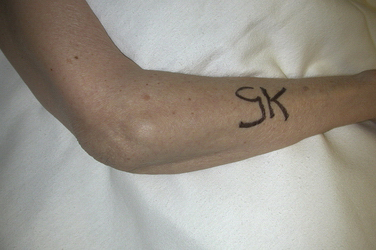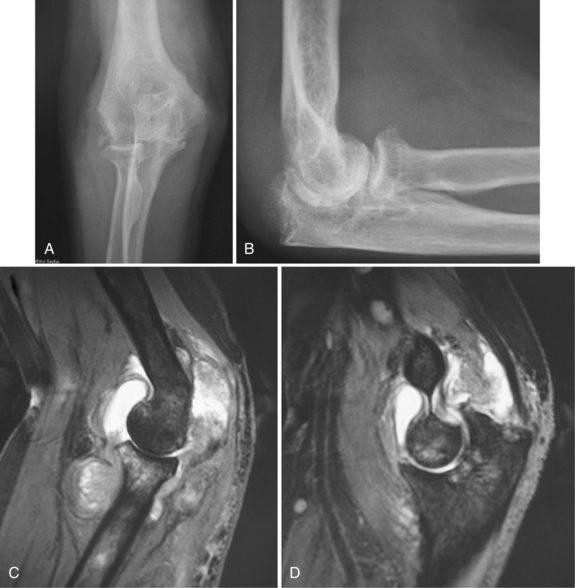CHAPTER 11 Arthroscopic Synovectomy for Inflammatory Arthritis
PATIENT EVALUATION
History and Physical Examination
Physical examination often reveals a boggy swelling posterolaterally, which indicates synovitis or effusion (Fig. 11-1). The range of motion of the elbow and forearm should be documented with the use of a goniometer. If there is a loss of motion, a soft end point suggests a soft tissue cause, such as a tense effusion with synovitis or capsular contracture, whereas a firm end point suggests osseous deformity. For instance, the synovial tissue in patients with hemophilic arthropathy is hypertrophic, highly vascular, and prone to impingement between the articular surfaces. Synovectomy alone cannot address the loss of motion due to a bony abnormality. Limitation in rotation may be caused by radial head deformity and may need to be addressed by radial head resection at the time of the synovectomy (see Chapter 10). In the setting of rotational stiffness, examination and imaging of the wrist are important to rule out pathology of the distal radioulnar joint as a cause, especially in patients with rheumatoid arthritis, in which involvement of this joint is common.
Diagnostic Imaging
Plain radiographs of the elbow reveal the degree of joint destruction, which aids in estimating the expected efficacy of synovectomy in the rheumatoid elbow (Fig. 11-2A and B). The Mayo Clinic classification of rheumatoid elbows,11 which grades the severity of disease based on the radiographic appearance, can be useful in guiding treatment. Grade I is primarily synovitis with no radiographic changes other than periarticular osteopenia or soft tissue swelling. In grade II, there is narrowing of the joint, but the architecture of the joint is intact. In grade III, there is alteration of the subchondral architecture of the joint, such as thinning of the olecranon or resorption of the trochlea or capitellum. In grade IV, there is gross destruction of the joint. Grade V is ankylosis.
Computed tomography (CT) can better define the osseous anatomy, including osteophytes and deformity of the radial head. Radial head deformities identified on imaging may need to be addressed by radial head resection at the time of the synovectomy (see Chapter 10). Magnetic resonance imaging (MRI) is useful for determining the extent of synovitis and nonossified loose bodies (see Fig. 11-2C and D).
Indications and Contraindications
Rheumatoid arthritis of the elbow is the most common indication for arthroscopic synovectomy in inflammatory arthritis.1–4 Synovectomy for rheumatoid arthritis of the elbow is indicated in the setting of persistent, painful synovitis with associated loss of function despite an adequate trial of medical management. Although the best results are seen in patients with some preserved articular cartilage and only mild bony deformity, arthroscopic synovectomy also should be considered in patients with more advanced disease who are younger or have pauciarticular disease. Arthroscopic débridement and synovectomy is a reasonable option in this group given the concerns about the longevity of total elbow arthroplasty.
Arthroscopic synovectomy is used to treat patients with hemophilia who have recurrent elbow hemarthroses and synovitis.5–7 Patients should have failed treatment with factor replacement for 3 to 6 months before being considered for synovectomy.8 With improved factor replacement, the incidence hemophilic patients with persistent synovitis requiring surgery seems to be decreasing over time. Arthroscopic synovectomy is also indicated for psoriatic arthritis and acute septic arthritis.9
Inadequate expertise of the treating surgeon is a contraindication to arthroscopic synovectomy. Arthroscopy of the rheumatoid elbow is technically demanding and has been associated with an increased risk of nerve injury.12 Patients with greater stiffness and deformity have diminished capsular volume, reducing the working room in the elbow.13 Initial visualization is often poor, and the capsule is often very thin and friable, increasing the risk of inadvertent capsulectomy and nerve injury. Surgeons with less arthroscopic experience should manage these patients with open surgery or refer them to someone more skilled at advanced arthroscopic techniques of the elbow.
Advanced articular destruction and bony deformity is a relative contraindication. The results of synovectomy are less favorable in this setting. Gross instability, often a result of severe joint destruction, is considered a contraindication, because synovectomy cannot address symptoms related to instability and may instead aggravate these symptoms.14
Treatment Alternatives
Alternative surgical treatment options include open synovectomy, combined synovectomy and radial head excision, interposition or excisional arthroplasty, and total elbow arthroplasty. Open synovectomy is a safer option in the hands of surgeons with less arthroscopic experience and is well supported by the literature for the treatment of rheumatoid synovitis in early stages of the disease.15–30
Conversion to an open procedure should be performed if there is an inadequate view to proceed safely or a slow progression of the arthroscopy due to technical challenges. Historically, most reports of open synovectomy for rheumatoid arthritis have included a radial head resection.15–30
Stay updated, free articles. Join our Telegram channel

Full access? Get Clinical Tree










